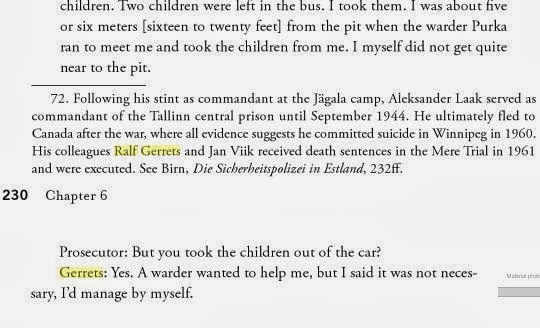Peoples ' behavior
as of individuals differ greatly depending on the circumstances . It is in the
toughest times when you see the moral quality of those peoples or individuals .
The Germans
killed thousands , millions of women, elderly and children not alone , but with
many accomplices , among the biggest enthusiasts and accomplices are the Baltics.
Yes these are now trying to introduce themselves as a mini Nordic states . Even
there was an Estonian SS battalion.
While the crimes
of the Germans have been difficult to hide (though they have tried it and continue
doing, exposing themselves as victims) the Baltics , as the Ukrainians had it
easier because of its large emigration to English-speaking countries , especially
Canada , USA and England
That is the
main problem .To be anticommunist or have left communist countries (usually with exit permit
, not running at night by the countryside, yes it was possible after 1945 for many people, the Iron Curtain had a lot of holes ) was a pass for everything.
And the only
version of the history of those countries that reached the inhabitants of the
Anglo-Saxon countries and most Western countries was narrated for them. As usual the Russians were devils and, of course, silenced all about their own crimes and those of the Germans.
Now it has a
little more difficult, Russia
And above all, the sadest thing is that as in Germany the majority of the population agreed with these atrocities in an active or passive form , and that feeling has not gone away, the tributes to veteran Nazi murderers increase every year among other acts.
An example among many :
A
number of Holocaust trials in
Soviet Estonia were held in
the 1960s.The best-known trial was brought in 1961, by the local Soviet authorities against Estonian collaborators who had
participated in the execution of the Holocaust during the Nazi German occupation (1941–1944).
The accused were charged with murdering up to 5000 German and Czechoslovakian Jews and Gypsies near the Kalevi-Liiva concentration
camp in 1942–1943. The public trial by the
Supreme Court of the Estonian SSR was held in
the auditorium of the Navy Officers Club in Tallinn and attended
by a mass audience. All three defendants were convicted and sentenced
to death, two of them were executed shortly after. The
third defendant, Ain-Ervin
Mere was tried in absentia and was not
available for execution.
 |
| Estonian camps and killings sites |
The crimes
While the
accused may have been involved in other crimes against humanity during the German occupation of Estonia,
the trial focused on the events of September 1942. According to testimony of
the survivors, at least two transports with about 2,100–2,150 people, arrived
at the railway station at Raasiku,
one from Theresienstadt (Terezin)
with Czechoslovakian Jews and
one from Berlin with German citizens.
Around 1,700–1,750 people, mainly Jews, not selected for work at
the Jägala camp were
taken to Kalevi-Liiva and shot
The accused
·
Ain-Ervin Mere, February 22, 1903 – April 5, 1969 ,commander of the
Estonian Security Police (Group B of the Sicherheitspolizei) under the Estonian
Self-Administration, was tried in absentia. Before the trial he was an active member of the Estonian
community in England England
According to testimony by one of the accused, Gerretts, eight busloads
of Estonian auxiliary police had arrived from Tallinn. A selection process was
supervised by Ain-Ervin Mere, chief of Sicherheitspolizei in Estonia
 |
| Viiks and Gerrets in the Tallin Trial |
On 5 September 1942 a train with
approximately 1,500 Czechoslovak citizens arrived to the Raasiku railway station. Mere,
Laak and Gerrets personally selected
who of them should be executed and
who should be moved to the Jägala death camp. More than 1,000 people, mostly
children, the old, and the infirm, were translocated to a wasteland at
Kalevi-Liiva where they were monstrously executed in a special pit. In
mid-September the second troop train with 1,500 prisoners arrived to the
railway station from Germany
·
Jaan Viik, (Jan Wijk, Ian Viik), a guard at the Jägala labor camp was
singled out for prosecution out of the hundreds of Estonian camp
guards and police for his particular brutality. He was testified as throwing small
children into the air and shooting them. He did not deny the charge.
Estonian auxiliary forces assisted
the German Einsatzgruppen (mobile killing units) in the mass killing of Jews
and others during World War II. Ralf Gerrets and Jaan Viik were both members of
the Estonian security police during the German occupation. This footage shows
them during their trial, on charges of war crimes, in the Estonian
Soviet Socialist Republic . The Estonian Supreme Court found both
guilty and sentenced them to death in 1961.
A
link to the Tallin trial ( Russian with subtitles in English ) 1min 40´´ :
A frightening example of how these Estonian murderers acted is written in the book
Children during the Holocaust ( Patricia Heberer )
·
A fourth accused, camp commandant, Aleksander Laak ( 1907 Pöide Parish, Estonia Winnipeg Canada ) was discovered in Canada
He was a lieutenant and the commander of
the Jägala concentration camp during the German occupation of Estonia.
The estimates for the number
of killed at Jägala concentration camp vary widely. The Soviet
investigators reached the
conclusion that 2,000–3,000 were killed in Jägala, but the number 5,000 (as determined by the Extraordinary State Commission in 1944) was
written into the verdict.
He
was also known to
have arranged drunken orgies with girls inmates and after killed them.





No comments:
Post a Comment